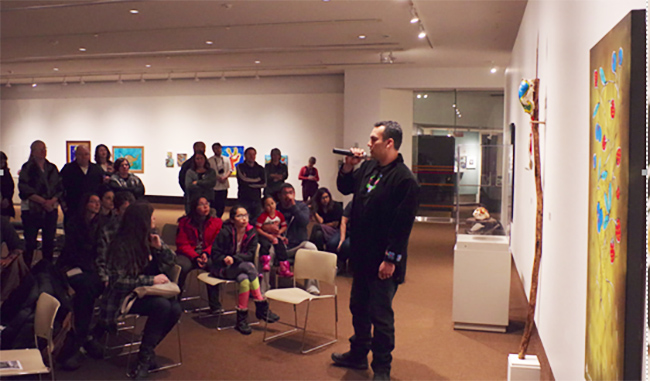Biinjitiwaabik Zaaging Anishinaabek and Red Rock artists part of Converging Lines exhibit

By Rick Garrick
THUNDER BAY – Birch bark is featured in the work of two artists from the Northern Superior Region at the Thunder Bay Art Gallery’s Converging Lines: Recent Artwork from the Northwest exhibition.
“I heat my house with birch, so I wanted to make better use of the birch tree than simply burning it all for heat, to sort of honour the birch,” says Shaun Hedican, who lives in Biinjitiwaabik Zaaging Anishinaabek, during the Converging Lines: Recent Artwork from the Northwest Panel Discussion and Reception on Jan. 21. “So one thing I’ve been doing is dry distilling a lot of the bark, as well as painting on the bark. Dry distilling is like burning without oxygen. So you have a container that is more or less airtight, and you put the bark inside there and apply high heat and the pitch will seep out.”
One of Hedican’s artworks in the exhibition, which opened on Nov. 24 and closes on Feb. 25, was an eagle staff project made from Saskatoon wood treated with birch pitch.
“This is the beginnings of my Eagle Staff project,” Hedican says. “I included the bear — some of you may know already that I use a lot of bear symbolism. It represents my spirit guide.”
Hedican says a bear visited him one night while he was in a tent at his family’s camp on Lake Nipigon.
“Later that summer I made a drum, and when we put bear grease on that drum, that (bear) symbol appeared,” Hedican says. “It was a transparent spot on the hide.”
Red Rock Indian Band’s Cree Stevens also shared some of her birch bark artworks in the Converging Lines exhibition.
“A lot of my influences come from Woodland art,” Stevens says, noting that her mother always had artwork by Indigenous artists in their home. “As much as I loved that art, for some reason my focus or my goal from the beginning has been to use traditional materials that my people have used for years, but to make something new or use materials in a way that people hadn’t used them before or at least that I hadn’t seen them used before.”
Stevens says she tries to focus on wigwas, birch bark, in her artwork.
“It kind of just happened over a period of time,” Stevens says. “I started to use it in some of my art, and then when I couldn’t find the pieces I wanted to use for my art, I made them. So the first piece that I really made was the Wigwas Shawl.”
Stevens says she revitalized the Wigwas Shawl in one of her artworks in the exhibition.
“I like the idea of wearing a shawl and wearing birch bark as a protective part of that shawl,” Stevens says. “Birch bark has been important to all of us in this region for many different reasons, practically, artistically. Everything about it I love, and I didn’t realize how much I loved it until I actually started working with it as much as I have now.”
The exhibition, which was organized by Thunder Bay Art Gallery curator Nadia Kurd, also features the work of two other Indigenous artists: Kristy Cameron and Elliot Doxtater-Wynn.
“It’s been a very popular exhibit,” says Sharon Godwin, director of the Thunder Bay Art Gallery. “(Kurd) was intrigued by how (the artists) draw inspiration from other Anishinabe artists, people we know and love, Norval Morrisseau, Roy Thomas, Ahmoo Angeconeb, and specifically about the power lines in their work. So that’s the title: Converging Lines.”


